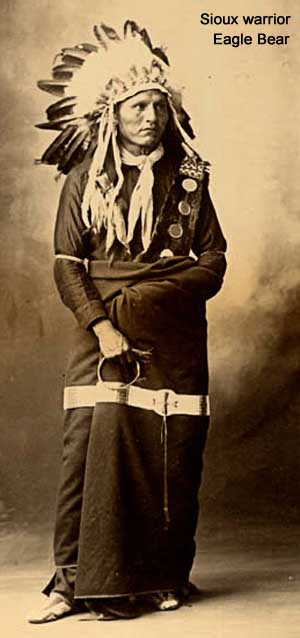|
||||||||||||
Bruce Brown's 100 Voices... Eagle Bear's Story of the Battle
EAGLE BEAR'S ACCOUNT #1
[EAGLE BEAR] was standing under a crudely -- built sun shelter in front of his one-room log cabin where he lives with his brother, Fool's Crow. Eagle Bear's long, gray hair, parted in the middle, hung in two braids down his back. He wore an old pair of corduroy trousers, a faded blue shirt and shabby moccasins. A blue bandanna handkerchief was tied around his neck.... "Eagle Bear, how did the battle with Custer begin?" the woman interpreter, Josephine, put the question to the Indian. The word "battle" was used judiciously because old-time Indians dislike the word "massacre" in describing Custer's defeat. The Indian looked stolidly at the ground, then grunted a few words. "He says the fight happened so long ago he must think awhile," Josephine said.... "Custer was the blame for the battle," Eagle Bear said, speaking slowly. "Our people wanted peace. We did not want to fight the white men anymore. If Custer had not fired on us, we would not have killed him and his soldiers. "Custer first shot and killed an Indian boy who was camped with his father a few miles below our village. The boy was helping his father skin a buffalo when the soldiers fired into their camp. The soldiers rode on, but the father jumped on his horse and hurried to tell us what had happened. "None of the Indians expected a fight. The children were swimming in the river and playing on the bank. The women were cooking and packing their stores as we planned to break camp. "Far in the distance we saw a thick cloud of smoke. There was great fear and excitement among my people when we knew the soldiers were coming. We were not prepared to fight, and even when we saw the soldiers coming, we did not make ready for battle. "Before Custer arrived, another band of soldiers attacked the lower end of the village, about three miles from Eagle Bear's tepee, he said. It was Reno's troops. The Indians there quickly drove them to refuge in a fringe of timber, where the soldiers stayed until Benteen's men came several hours later. "When Custer's men drew near our camp they fired at us," Eagle Bear continued. "Many of our warriors rode into a ravine where Custer could not see them but through which he would have to pass to reach our village. "Custer's men kept coming. My father sent me running to find my mother and sister who were digging wild turnips near the river. He told me to see that they fled to safety. They had already gone when I got there, so I hurried back. The fight with Custer was just starting. "Our men, catching Custer by surprise, had driven him out of the ravine to the top of a small hill. I hurried to join the fighters. We could not ride in a circle around Custer's soldiers because they were on one edge of the hill. There were great numbers of us, some on horseback, others on foot. Back and forth in front of Custer we passed, firing all of the time. We were yelling and screaming. The soldiers were falling fast. Then we rode suddenly right into Custer's men and killed all who were still alive. The massacre did not last longer than fifteen minutes," Eagle Bear said. "When the soldiers were dead, the young boys between the ages of ii and 15 years old ran from one body to another, shooting arrows and firing rifles into them, scalping them and stripping their clothes. The boys were more cruel than the warriors. "Only Custer's body went untouched. He was the chief and our people had great respect for the white man's chief." Eagle Bear could not recall how many warriors were in the battle, but he believed there were several thousand.... "Would you like to be a warrior again, live in big camps with your people, [and] fish and hunt?" It seemed a natural question to ask of the old Indian. Eagle Bear answered without hesitation. "When I was young, I liked to fight. But now that I'm old and it doesn't interest me any more, I am contented to live quietly here with my horses. . . ." Indian Views of the Custer Fight: A Source Book by Richard G. Hardorff, The Arthur Clark Co. Spokane, WA 2004, p 187 - 189
Here is another account of the battle by Eagle Bear.
|
||||||||||||




 Pine Ridge, South Dakota
Pine Ridge, South Dakota 







